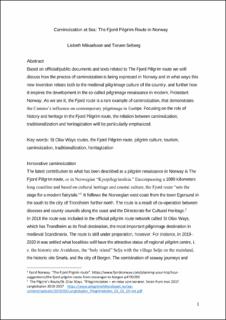Caminoization at Sea: The Fjord Pilgrim route in Norway
| dc.contributor.author | Selberg, Torunn | |
| dc.contributor.author | Mikaelsson, Lisbeth | |
| dc.date.accessioned | 2021-06-30T12:21:55Z | |
| dc.date.available | 2021-06-30T12:21:55Z | |
| dc.date.created | 2020-12-03T13:31:01Z | |
| dc.date.issued | 2020 | |
| dc.Published | Numen. 2020, 67 537-556. | |
| dc.identifier.issn | 0029-5973 | |
| dc.identifier.uri | https://hdl.handle.net/11250/2762575 | |
| dc.description.abstract | Based on official church and public-sector documents and texts related to the Fjord Pilgrim Route, we discuss how a process of Caminoization is expressed in Norway, both in relation to how this new invention relates to the medieval pilgrimage culture of the country, and how it inspires developments in the so-called pilgrimage renaissance in modern, Protestant Norway. The new construction of the Fjord Route demonstrates not only the Camino’s influence on contemporary pilgrimage in Europe, but also its scope for innovation in a broad field that encompasses state, church, country, and tourist organization actors. Focusing on the role of history and heritage in the Fjord Pilgrim Route, we argue that Caminoization, traditionalization, and heritagization are key factors that affected the establishment of the new Fjord Route and Norwegian pilgrim culture. | en_US |
| dc.language.iso | eng | en_US |
| dc.publisher | Brill | en_US |
| dc.title | Caminoization at Sea: The Fjord Pilgrim route in Norway | en_US |
| dc.type | Journal article | en_US |
| dc.type | Peer reviewed | en_US |
| dc.description.version | acceptedVersion | en_US |
| dc.rights.holder | Copyright 2020 Koninklijke Brill NV | en_US |
| cristin.ispublished | true | |
| cristin.fulltext | postprint | |
| cristin.qualitycode | 2 | |
| dc.identifier.doi | https://doi.org/10.1163/15685276-12341601 | |
| dc.identifier.cristin | 1855829 | |
| dc.source.journal | Numen | en_US |
| dc.source.40 | 67 | |
| dc.source.pagenumber | 537-556 | en_US |
| dc.identifier.citation | Numen. 2020, 67(5-6), 537–556 | en_US |
| dc.source.volume | 67 | en_US |
| dc.source.issue | 5-6 | en_US |
